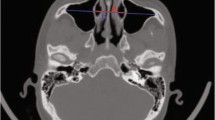Abstract
The aim of the study was to investigate the relationship between nasal septal deviation and the middle turbinate hypertrophy using computed tomography. In this retrospective analysis, we examined 77 patients with nasal septal deviation. The mucosal and bone structures of the middle turbinate and the angle of the septum were measured using radiological analysis. Measurements of the middle turbinate on the convex side were compared to those on the concave side. Measurements of the bony and mucosal structure area of the middle turbinate were significantly greater than those on the concave side. The dimensions of medial mucosa thickness and bone thickness were not significantly different between the convex and concave sides. No significant correlation was found between the angle of deviation and other parameters. The present findings suggest that compensatory middle turbinate hypertrophy was caused both by conchal bone growth and mucosal hypertrophy in patients with nasal septal deviation.



Similar content being viewed by others
References
Ozcan KM, Selcuk A, Ozcan I, Akdogan O, Dere H (2008) Anatomical variations of nasal turbinates. J Craniofac Surg 19:1678–1682
Aydil U, Ozçelik T (2010) Unilateral agenesis of middle nasal turbinate. J Laryngol Otol 124:447–449
Christmas DA, Mirante JP, Yanagisawa E (2012) Endoscopic view of compensatory hypertrophy of the middle turbinate. Ear Nose Throat J 91:230
Gray LP (1978) Deviated nasal septum. Incidence and etiology. Ann Otol Rhinol Laryngol Suppl 87:3–20
Courtiss EH, Goldwyn RM, O’Brien JJ (1978) Resection of obstructing inferior nasal turbinates. Plast Reconstr Surg 62:249–257
Berger G, Hammel I, Berger R, Avraham S, Ophir D (2000) Histopathology of the inferior turbinate with compensatory hypertrophy in patients with deviated nasal septum. Laryngoscope 110:2100–2105
Korkut AY, Islim F, Gulseven Ciftci S, Dogan R, Gedikli O, Kahya V, Gunes G (2012) Evaluation of inferior turbinate hypertrophy in patients with congenital and traumatic nasal septum deviation. J Laryngol Otol 126:784–788
Akoğlu E, Karazincir S, Balci A, Okuyucu S, Sumbas H, Dağli AS (2007) Evaluation of the turbinate hypertrophy by computed tomography in patients with deviated nasal septum. Otolaryngol Head Neck Surg 136:380–384
Kim DH, Park HY, Kim HS, Kang SO, Park JS, Han NS, Kim HJ (2008) Effect of septoplasty on inferior turbinate hypertrophy. Arch Otolaryngol Head Neck Surg 134:419–423
Orhan I, Aydın S, Ormeci T, Yılmaz F (2014) A radiological analysis of inferior turbinate in patients with deviated nasal septum by using computed tomography. Am J Rhinol Allergy 28:e68–e72
Ng BA, Ramsey RG, Corey JP (1999) The distribution of nasal erectile mucosa as visualized by magnetic resonance imaging. Ear Nose Throat J 78:163–166
Egeli E, Demirci L, Yazýcý B, Harputluoglu U (2004) Evaluation of the inferior turbinate in patients with deviated nasal septum by using computed tomography. Laryngoscope 114:113–117
Busaba NY, Shin HJ, Faquin WC (2006) Correlation between middle turbinate and ipsilateral ethmoid histopathology in chronic rhinosinusitis. Otolaryngol Head Neck Surg 134:250–254
Luo X, Liang C, Xu K, Tang S, Ren X, Liu D (2012) Influence of nasal septal deviation on incidence of bilateral sinusitis. Lin Chung Er Bi Yan Hou Tou Jing Wai Ke Za Zhi 26:777–780
Kaygusuz A, Haksever M, Akduman D, Aslan S, Sayar Z (2014) Sinonasal anatomical variations: their relationship with chronic rhinosinusitis and effect on the severity of disease-a computerized tomography assisted anatomical and clinical study. Indian J Otolaryngol Head Neck Surg 66:260–266
Balbach L, Trinkel V, Guldner C, Bien S, Teymoortash A, Werner JA, Bremke M (2011) Radiological examinations of the anatomy of the inferior turbinate using digital volume tomography (DVT). Rhinology 49:248–252
Savvateeva DM, Güldner C, Murthum T, Bien S, Teymoortash A, Werner JA, Bremke M (2010) Digital volume tomography (DVT) measurements of the olfactory cleft and olfactory fossa. Acta Otolaryngol 130:398–404
Acknowledgments
We thank Associated Professor Ünal Erkorkmaz, Department of Biostatistics, Training and Research Hospital at the University of Sakarya, for their help.
Conflict of interest
We have no actual or potential conflict of interest in relation to this paper.
Author information
Authors and Affiliations
Corresponding author
Rights and permissions
About this article
Cite this article
Demir, D., Asil, K., Güven, M. et al. Assessment of the correlation between nasal septal deviation and compensatory hypertrophy of the middle turbinate. Eur Arch Otorhinolaryngol 272, 2847–2851 (2015). https://doi.org/10.1007/s00405-014-3387-6
Received:
Accepted:
Published:
Issue Date:
DOI: https://doi.org/10.1007/s00405-014-3387-6




